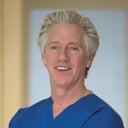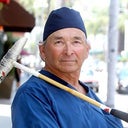In general, hair loss occurs when the hair root is damaged. This damage occurs from either cutting the hair roots while incising the skin, or when electro-cauterizing any bleeding spots, that are near hair roots, or when there is so much suture or "staple" tension on the skin that the blood vessels that bring nutrients and oxygen to the skin aren't relaxed enough to stay open. Hair loss from incision, however, occurs just along the incision line -- at most only affecting a 3 or 4 millimeter area next to the incision. This loss can be minimized by the surgeon by slanting the cut in the direction of the hair follicles. Hair loss from cauterization and suture tension can produce a larger spot, both by compromising the blood supply. If the spots are symmetrical on both sides, then it's most likely due to same design and tension in same areas on both sides. If spots are not symmetrical, then probably a cautery issue.The loss from tension is often temporary since the decreased blood supply can be diminished enough to "shock" the hair into falling out, but not enough to kill it. There has to be quite a bit of tension for the loss to be permanent - however this is certainly possible. Have somebody use a magnifying lens to look at the skin in this area. If there is even a little bit of fine or fuzzy hair seen coming out the skin, then that hair is very likely to grow back (of course, this takes a long time however). If the skin is shiny smooth with no evidence of fine, fuzzy hair regrowth, then the loss is permanent and the only way to make it look better is to either cut out the bald area, undermine the scalp widely to create more laxity, then re-close the skin under less tension. However, to let the skin relax enough after the first surgery, it's recommended to wait at least a year to do this. The other way is to transplant some new hair follicles in this area, which can be done at least three months out from surgery. And, of course, your other option is to just maintain a hair style that covers the area adequately.



